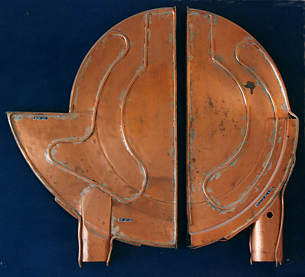



a primer on the Lessons of the Quantum
The text and photos of the PDF are reproduced below as a single web page.
It is not expected to be easy reading. Topics are condensed to keep the original
"children's book" format to 16 pages.
text & photos by
Scott Ready
P.O. Box 1350
Grand Lake, Colorado 80447
relax@MountainLake.com
www.MountainLake.com
March, 2010 ©
For additional web sources besides Googling for key phrases and names in this primer, visit
http://www.quantum.at
http://iqoqi.at
http://www.nbi.ku.dk
http://nba.nbi.dk
http://research.physics.illinois.edu/QI/photonics
 is for Elephant
is for Elephant
It was six men of Indostan*
To learning much Inclined,
Who went to see the Elephant
(Though all of them were blind),
That each by observation
Might satisfy his mind
The First approached the Elephant,
and happening to fall
Against his broad and sturdy side,
At once began to bawl:
"God bless me! but the ElephantIs very like a wall!"
The Second, feeling of the tusk,
Cried, "Ho, what have we here
So very round and smooth and sharp?
To me 'tis mighty clear
This wonder of an Elephant
Is very like a spear!"
The Third approached the animal,
and happening to take
The squirming trunk within his hands,
Thus boldly up and spake:
"I see," quoth he,
"The Elephant is very like a snake!"
The Fourth reached out an eager hand,
and felt above the knee,
"What most this wondrous beast
is like Is mighty plain" quoth he;
"'Tis clear enough the Elephant
Is very like a tree!"
The Fifth who chanced to touch the ear,
Said: "E'en the blindest man
Can tell what this resembles most;
Deny the fact who can;
This marvel of an Elephant
Is very like a fan!"
The Sixth no sooner had begun
About the beast to grope,
Than, seizing on the swinging tail
that fell within his scope,
"I see," quoth he, "the Elephant
Is very like a rope!"
And so these men of Indostan
Disputed loud and long,
Each in his own opinion
Exceeding stiff and strong,
Though each was partly in the right,
And all were in the wrong!
MORAL
So oft in theologic wars,
The disputants, I ween,
Rail on in utter ignorance
Of what each other mean,
And prate about an Elephant
Not one of them has seen!
* from The Poems of John Godfrey Saxe
Boston: James R. Osgood and Company, 1873
pages 135-136, The Blind Men and the Elephant
subtitled: A Hindoo Fable
section: Fairy Tales, Legends and Apologue
PROLOGUE
My first encounter with the literature on quantum physics was in 1965 when I checked out George Gamow's Mr Tompkins in Wonderland. It was from my school library in Maadi, a few miles south of Cairo, Egypt at Cairo American College, an international English-speaking school with grades from kindergarten through twelve. I was in the fourth or fifth grade. Mr. Gamow's book also had an introduction to Einstein's Theory of Relativity. Many years later, I learned that Gamow was a distinguished physicist who started in Russia and tried to escape by kayak with his wife during Stalin's regime. After fruitful time at the Niels Bohr Institute in Copenhagen, during which he pioneered research in the hot big bang theory and also quantum tunneling, he finally settled in Boulder, Colorado where, as he put it, his son could be a cowboy. The two tallest buildings on the University of Colorado campus at Boulder are named the Gamow Towers in his honor. (The w in Gamow is pronounced as a v.)
I arrived in Boulder as a graduate student in mathematical physics eight years after George Gamow's death. I eventually learned that Mr. Gamow and I have the same birthday, March 4. I presume that these coincidences and others are accidental and not worth mentioning except for the sake of creating a story. For example, Niels Bohr was a Knight of The Order of the Elephant, Elefantordenen.
I focused on learning Einstein's General Relativity and in understanding the singularity theorems in a very dense book by Hawking and Ellis called The Large Scale Structure of Space-Time. I toyed a bit with Feynman's path integral approach to quantum mechanics and I also maintained my interests in engineering, especially its more down to earth and practical aspects. The abstractness, difficulty and endlessness of mathematical physics did not sit well with me. After I graduated, on occasion as a hobby, I used my mathematical background to properly review and study quantum mechanics. I often thought about how clever and appealing Gamow's presentations were. I contemplated writing something succinct on quantum physics that would be educational and entertaining to beginners. Around the late 1980's, I had in hand, the draft for a short book. Gamow's publisher, Cambridge University Press, wrote to me and encouraged me to submit a final version.
Be that as it may, I was never sure about my whole understanding of this quantum business. There were a number of popular expositions in the market, some by real physicists, that I felt were as misleading as they were helpful. Recessed in my memory was also an experience that I had at the Cairo American College library, an experience that is perhaps not possible today, as it would be considered to be "politically incorrect". After reading Gamow's Wonderland book I was prompted to look for additional resources on Einstein's Relativity. Right at that time (circa 1965), the library had a display of books on a round table with a large placard set in the middle that said "Pseudoscience". This was a new word for me and a revelation at my tender age of ten. Until then, I had assumed that anything hardbound as a book is truthful information, if it is written in the language of science and mathematics. That tabletop demonstration served me well and has kept me out of much of the trouble that is in presentations of quantum physics. It has also made it very difficult for me to write anything conclusive about the subject, even though I have been acquainted with it off and on for 45 years. In a short presentation it can be very difficult to not sound cavalier or to use what Wikipedia calls “weasel words”!
There are chasms between rigorous experimental physics and abstract mathematical physics and even larger voids from these disciplines to their various popularizations. A lot gets lost in translation from one discipline to another and the disciplines themselves are fractured in a hundred different ways. One would have to be an inside expert to really spot when phrases do what weasels do, which is suck out the insides of an egg and leave with you something that looks intact on the outside and yet is hollow and void of meaning and is incapable of bearing fruit.
Through the years, I have had a few opportunities to discuss with leaders of the field, even visionaries (like John Wheeler), the challenges in presenting quantum physics to non-experts (including myself). In the year 2002, I made a pil-grimage to the Niels Bohr Institute in Copenhagen. I was surprised to see 100 meters of wild graffiti on the wall the Institute shares with Fælled Park. In the photo [below], one can see the Institute's mid-level windows over the wall. A couple of years later, in Decem-ber of 2004, I was able to visit briefly with Professor Anton Zeilinger in Vienna. He kindly talked with me and then let me photograph some of his experiments.
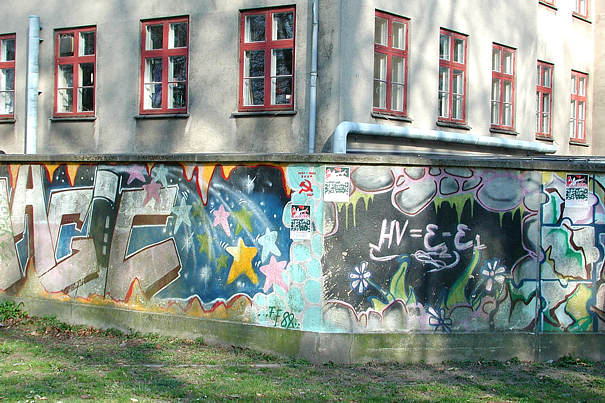
The large cartoonish mural on the Park's side of the Bohr Institute had been up for 14 years by the time I photographed it. It may no longer be visible; I can not find past images of it using Google. The image at the bottom of page 4 has the artist's initials, TF, and the date 88. It includes a simple and famous formula by Bohr from his 1913 article. This formula for a quantum jump in energy was once on a Danish postage stamp. The image to the right has the huge letters (in English) saying “House of Magic”.

Inside the Institute, I was allowed to see the remains of its cyclotron and also to visit Bohr's personal office.

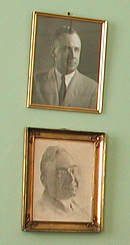
On his wall is an array of photographs of him with the attendees of the many conferences that were so important in his life. The two individuals given rather large photographs in this view of his office are John Wheeler and George Gamow, great physicists who are also noteworthy for their popularizations of quantum mechanical experiments and theory.
In February of 2010, circumstances made it possible for me to visit with Paul Kwiat of the University of Illinois at Urbana-Champaign and to share with him my hope for a clear exposition of what quantum physics is trying to tell us. On my way to Loomis Laboratory for our appointed meeting, I tried to come up with a mnemonic device to help me navigate through the different topics that I wanted to discuss with him. I decided to use the body of an elephant. As I ascended the stairwell of Loomis Laboratory to Kwiat's office on the third floor, I noticed the copper shell of a cyclotron mounted in the stairwell. My photograph of it is on the cover of this primer. As I gazed upon it, I weighed in my mind the wealth of physics that has come out of this small elephant-shaped object only a few feet across. I also considered how the experiments of Kwiat's group—fifty years after the little cyclotron's heyday—are also small and path breaking. I do not fully understand the experiments of Kwiat's or Zeilinger's groups, and yet I feel that they lead the way in unraveling the lessons of the quantum. Over and beyond the technological promise of the experiments, they are important because they are relatively inexpensive to replicate and they have a high degree of educational transparency in contrast with the vastly more complicated experiments of CERN or those of a modern medical lab. They are reminiscent of the way science used to be before the 20th century, back when curious individuals would experiment with basic chemistry, electricity and magnetism on a single table top.
This little primer is a summary of what I know about this strange quantum business. I have put everything under the heading of ELEPHANT, in memory of the fable of the blind men encountering something large and strange. As John Preskill and Leonard Susskind have shown, once memories are made, the elephant never forgets. Perhaps this is a one-sided view in which information can be created and yet not destroyed. It could have something to do with the direction of time and making time. Or it could be that Preskill and Susskind feel that information is never created, but instead it is conserved for all time, albeit entangled in many forms.
Without further ado, let us get to the heart of the matter and unpack the elephant.
 is for Elephant. E is for Experiments. E is for Entanglements. Is there a rigorous formula for measuring entanglement? Are measures for
entanglement the same as those for Entropy? For a gifted educator, the Promethean task is to bring the formulae for entanglement and entropy down from
Olympus so that ordinary people can benefit from them as people benefit from the gift of fire. John Wheeler brought Einstein's lessons of covariance down to
the introductory physics level where it belongs. Can the same be done for the Lessons of the Quantum? Many have tried to do so, yet in their descriptions of
how a measure-ment creates aspects of reality, they have come dangerously close to bringing more confusion than enlightenment. If the heart of physics is
about what remains the same, over and above all of the transformations that are occurring, then how can physics properly deal with creativity?
is for Elephant. E is for Experiments. E is for Entanglements. Is there a rigorous formula for measuring entanglement? Are measures for
entanglement the same as those for Entropy? For a gifted educator, the Promethean task is to bring the formulae for entanglement and entropy down from
Olympus so that ordinary people can benefit from them as people benefit from the gift of fire. John Wheeler brought Einstein's lessons of covariance down to
the introductory physics level where it belongs. Can the same be done for the Lessons of the Quantum? Many have tried to do so, yet in their descriptions of
how a measure-ment creates aspects of reality, they have come dangerously close to bringing more confusion than enlightenment. If the heart of physics is
about what remains the same, over and above all of the transformations that are occurring, then how can physics properly deal with creativity?
Physicists like Leonard Susskind, John Preskill and Charles Bennett have given compelling reasons for there to be a measure of information in physics that remains preserved, even when entropy is increasing very rapidly. In this quantum business, the elephant never forgets. Let the elephant's long and precious tusks be a reminder of the possibility of there being a "conservation of information" law in physics. Like the enamel of teeth, ivory endures and it can be used to recover a fair amount of information about a species. Ivory is also now a conserved quantity. It may be that by conservation of information we mean little more than that Schrödinger-like equations are unitary: <v|w> = <Rv|Rw> where R is an operator that effectively does nothing more than a Rotation in some abstract space. Perhaps Susskind and company have something more in mind.
When one walks into Paul Kwiat's office in the Department of Phyisics at the University of Illinois and into his laboratory, one sees papers and documents piled high and simple looking electronic and optical devices spread out and partly connected like a kid's jumble set of tinker-toys in the middle of a project. It does not look very organized; papers, tools and devices are lost and found. As the head of his group, it is partly Kwiat's business to keep track of the inventory and to summarize what is going on. Out in the hallway, there are big posters with diagrams and graphs which are like mnemonic devices to algorithmically encapsulate and recall what all of the fuss is about.
For a measure of information, one could try the following. The quantity of information in a system is the minimum number of qubits needed to encode it. This definition does not address the difference between quantity and quality and nor does not really capture what we might mean by algorithmic memory. An algorithm is a rule. Simple rules like conservation of energy, spin, charge and momentum encapsulate much of the information one gets, in a bubble chamber picture, for instance, or in balancing a chemical equation. A simple rule can cover a lot of ground; however can a rule for generating the Mandelbrot set, for example, really capture what one sees when exploring the fantastic imagery the rule generates?
The parts of the elephant that represent E for Entanglement are its mouth and hind end, because it is through those openings in particular that it is entangled with its surroundings although there are significant other openings: eyes, ears, skin pores and more. From the folds and wrinkles of the skin, a trained eye can read much into the elephant's history, health and age. The E for Entanglement is synonymous with the degree that its parts interact with and are mixed with its Environment. Each of these interchanges is concomitant with an increase of Entropy. Whatever was pure and virgin quickly becomes mixed, complicated, entangled and aged as the elephant takes in concentrated forms of energy and converts them to other forms to maintain its body in accordance with the 2nd Law of Thermodynamics. All of the following quantities increase in tandem: entropy, complexity, mixing, entanglement, aging, memories and information. Aging, Complexity, Mixing and Entanglements are all rolled into one, A Company Making Everything, ACME.
The simplest measure for ACME is area, as in the area of the event horizon of a black hole. For systems in general, its exposed surface area with its surroundings can often be a good first approximation of its degree of entanglement. The rougher, more wrinkled and convoluted the surface, the greater is its effective area and its number of receptacles for holding information. The maximum physical limit to the amount of information that can be embedded within the skin, or equivalently enclosed within the mass it surrounds, is the area of a black hole of equivalent mass. Quantum physics sets this limit. A classical treatment of ACME is not going to be the same as a quantum mechanical one.
 is for LOOSENESS. It is a reminder that Quantum Mechanics never says more than it must. The theory is gloriously silent just where it should
be. People have famously complained that the theory is incomplete and unrealistic. Under the banner of classical realism, they have been inclined to make up
things about nature for which it might be wiser to add nothing. People have a natural talent for filling in gaps. Imagination is a wonderful power, yet it can be
misused to create a misleading spin on events. As Mark Twain would have advised, “It is better to keep your mouth shut and appear stupid than to open it and
remove all doubt.”
is for LOOSENESS. It is a reminder that Quantum Mechanics never says more than it must. The theory is gloriously silent just where it should
be. People have famously complained that the theory is incomplete and unrealistic. Under the banner of classical realism, they have been inclined to make up
things about nature for which it might be wiser to add nothing. People have a natural talent for filling in gaps. Imagination is a wonderful power, yet it can be
misused to create a misleading spin on events. As Mark Twain would have advised, “It is better to keep your mouth shut and appear stupid than to open it and
remove all doubt.”
Case in point: only in certain specially prepared cases will Quantum Mechanics tell you exactly what a particular photon or electron will do. This is because it does not treat atomic particles as being individual and distinguishable entities, the way we commonly treat macroscopic objects. Quantum Mechanics is silent about individual events. It is always about the statistical outcome of collections (ensembles) of exactly repeatable setups. The theory is compatible with the stance that there need not be a reason for everything. There need not be as many equations as unknowns. Not everything is determined. There is a fundamental looseness in the ways things can be. The theory does not pretend to be a Theory of Everything (TOE) and it casts doubt on whether the existence of a TOE would be reasonable or realistic.
The looseness and incompleteness of Quantum Mechanics need not be a defect.
Quantum Mechanics leaves things not specified to the level of detail and tightness that classical physics would require. For some, this indicates a glaring incompleteness in the formulism; for others, it is a cause for celebration. As was noted by Richard Sheridan, in a different context and in a toast in 1802, “The glorious uncertainty of these laws was a thing well known and complained of, by all ignorant people, but all learned gentlemen considered it as its greatest excellency.”
Religious descriptions and hidden variable theories err in filling in where it would be wiser to presume nothing. If one can do an experiment and actually show how the gods on Olympus toy with us, then bravo! Don't be surprised however if the efforts come up empty handed. We need not assume that there is a glittering central mechanism or omnipotence underlying everything.
The first major advance in this direction was the discovery of the existence of inscrutable indivisible particles, “atoms” as Democritus called them. It is from this physical foundation that classical physics and quantum physics part company. Localism is untenable for quantized particles that can be swapped with no observable difference.
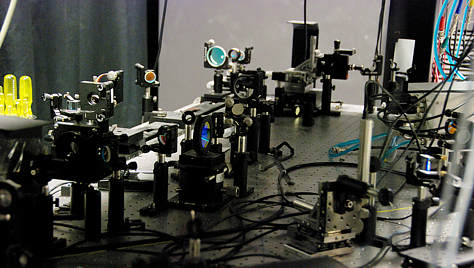
A quick look into a quantum optics benchtop experiment.
This one is from Paul Kwiat's group in Urbana-Champaign, Illinois (February, 2010).
A single benchtop experiment has in it a finite number of qubits. The information content of the qubits is not localized; it is instead embodied in the entire experimental framework. When one tries to divide where Planck's constant says to not divide, unwholesome filler is added to the story of nature in violation of the L for looseness in Quantum Mechanics and probably in violation of the uncertainty principles which are expressions of the indivisible character of Planck's quanta of action. The standard quantum formulism and uncertainty principles indicate that there is an inherent looseness and a limit to how much detail can be uncovered or is even possible. That does not mean that there can not be an experiment to find where Quantum Mechanics is self-limiting and in a sense wrong.
Information is dependent on global settings; it is not a local thing that one can resolve to infinite degrees. It is distributed and shared corporately, not as a sum of parts, but as the whole itself, undivided. Each component's grasp of the big picture is like a broken shard of the whole in low resolution. Like a piece of a hologram, it has within it information about everything, yet it is fuzzy. The resolution cannot necessarily be improved. Bits of information cannot be subdivided into ever finer degrees of additional information, because that would imply that the information content can be made arbitrarily large, to infinite degrees, in violation of the uncertainty principles. There is a point of understanding at which one can divide no further, without creating artificial distinctions.
Quantum Mechanics does not presume that information is localized where it can be parsed and deconstructed ad infinitum (as can, say, a segment of the real number line). A cornerstone of Quantum's Lesson is that it is the entire experimental setup that defines what we might observe. As with General Relativity, it is the way we cast our reference frame that determines what we see. As Niels Bohr wrote, Quantum Theory is an extension of Einstein's work and not in conflict with its spirit and character: “a comparison of purely logical aspects of relativistic and complementary argumentation reveals striking similarities as regards the renunciation of the absolute significance of conventional physical attributes of objects.” “... complementarity may be regarded as a rational generalisation of the very ideal of causality.” “In relativity theory, the emphasis on the dependence of all phenomena on the reference frame opened quite new ways of tracing general physical laws of unparalleled scope. In quantum theory, it was argued, the logical comprehension of hitherto unsuspected fundamental regularities governing atomic phenomena has demanded the recognition that no sharp separation can be made between an independent behavior of the objects and their interaction with the measuring instruments which define the reference frame.”*
The quantum postulate sets a limit as to how much information is available and the degree it might be localized. The L for Looseness is a reminder of the freedom an experimenter has in setting up his reference frame, right up to the last split second, through the insertion of a mirror or some other contrivance. The information that one gathers from an experiment is as much about how the whole experiment has been framed as it is about specific particles and properties observed within the setup.
Much has been written about the need for a fiery marriage between general relativity and quantum theory. No one knows how to consummate it. The joke on the naysayers is that the couple has been having unprotected premarital sex for years and being wonderfully prolific at it. An amazing amount of progress has been achieved in the last 40 years in understanding Black Holes, Cosmology and the 2nd law of Thermodynamics with Quantum Theory and Relativity working in tandem. This progress is evidence enough that the theories are more compatible and complete than the dissenting literature indicates. The original quantum gravity calculation was done by Bohr when he proved that Einstein’s thought experiment on the weighing of a box of photons could not violate the uncertainty principle.
When there is an equivalence class of ways for the same data to be obtained, the quantum formulism includes all of the possible ways (no matter how improbable) in a democratic each-way-one-vote Feynman sum of diagrams (or path integral). The formulism does not exclude a member unless one has specific instructions to do so built into the whole experimental setup and initial conditions. It is the LOOSENESS in quantum physics that allows for all of the crazy sums that Feynman would do and advised us to do if we are to keep up with refinements in experimental precision. Those sums include virtual particles and reversible processes that can wink in and out without causing an observable difference (except perhaps at the tenth decimal point of experimental precision).
A Mach-Zehnder interferometer makes a virtual process as large as the interferometer itself. When the device is calibrated to exactly split and recombine a photon's state vector, in effect it spatially shifts photons from their point of emission to their point of exit from the interferometer. The interferometer is mimicking a virtual process.
An essential body of mathematics in quantum mechanics is the use of 2-dimensional complex numbers. For a “particle” that has two states (like up or down for its axis), one has to use a complex number for each state. To keep track of BOTH states or any mixture in between, one has to use 2x2 dimensions. If one has two particles, one has to multiply that again times 2. Therefore, with just two particles with just two states each, one is quickly up to 2x2x2 = 8 dimensions or 8 degrees of freedom. The quantum formulism reduces this 8 to 6. A classical treatment would have only 4 degrees of freedom. The extra two degrees of freedom in the quantum formulism are due to entanglements that a classical treatment would miss. They create an additional looseness, flexibility and options that experimenters are just now learning to harness. This extra freedom in the way nature operates was once considered to be an incompleteness and defect of quantum mechanics. It is instead perhaps its greatest boon!
Let us now quickly unpack what is in the remaining letters of ELEPHANT.
 is for Energy. The second E in ELEPHANT is for the Protean thing called energy which can manifest itself in a dizzying array of forms and come
back unchanged, minus a tax paid to the 2nd Law of Thermodynamics with each conversion. On the one hand, energy is superabundant and cannot be
destroyed. On the other hand, it is scarce and difficult to obtain when people (and other forms of life) are hungry and in need of more power.
is for Energy. The second E in ELEPHANT is for the Protean thing called energy which can manifest itself in a dizzying array of forms and come
back unchanged, minus a tax paid to the 2nd Law of Thermodynamics with each conversion. On the one hand, energy is superabundant and cannot be
destroyed. On the other hand, it is scarce and difficult to obtain when people (and other forms of life) are hungry and in need of more power.
The 2nd Law of Thermodynamics enforces an entropy increase and heat-loss cost with each transformation of energy. However, through all of the changes, energy is still conserved; that is the 1st Law of Thermodynamics. Although Paul Kwiat does not doubt the validity of these laws, he finds even the 1st Law to be rather astonishing. Can all forms of energy really be equal?
There are people who, for religious reasons or for respect of their ancestry, do not treat different forms of energy equally. For example, the Amish have curious ways of handling electricity and horsepower (and then there are those curious Sabbath switches for the Jewish faith). The Amish power their pneumatic shop tools by having their energetic children pump their legs up and down on a bicycle-like contraption to compress air into a large tank. The Amish shun gasoline power in favor of horses. They also do not use conventional refrigerators; they convert electric ones to run on propane.
Be that as it may for matters of faith, religion and heritage, it all flies against the Galilean and Darwinian movements in science which have pretty much thrown down every cherished hierarchy and put everything on a democratic foundation of equality and gauge invariance. Stephen Wolfram's Principle of Computational Equivalence is on this same path that the scientific method has been carrying us for a great many generations.
If inequality is to have its place in the scheme of things, let us employ impartial experimental techniques to orient and guide our prejudices.
A great advantage of Kwiat's group is that its experiments are not prohibitively expensive or complicated. If Kwiat wished to make a fortune, he could pull a Stephen Wolfram; leave academia and market his treasure chest of tinker-toys to scientists, educators and hobby physicists around the world. With a few years of effort, he could have Chinese factories packaging the kits to charge little more than what it costs for Mathematica™.
We are lucky that our "Elephant" has two E's, because we need yet another E word to drive home the lessons of the quantum. E is for Exclusivity in the sense that with each decision we make make on how to set up an experiment (or experience), we at the same time exclude choices that are incompatible with this decision. One choice drives out and excludes another. There is a certain hardness in the way one choice crowds out other possibilities from sharing in the same moment. Every decision carries with it the cost of Excluded (forgone) opportunities. In chemistry, there is a distant yet related cousin called the Pauli Exclusion Principle. In its simplest form, it says that no two electrons can occupy the same state. When you add an electron to a group of electrons already bound to an atomic nucleus, it has to have its own exclusive orbital parameters—quantum numbers— different from that of any other bound electron. It can only occupy a state that is not already filled. There is a similar rule for packing identical protons or neutrons in an atomic nucleus. Each additional particle has to find its own unique seat; you can not have two in the same chair. The harder one tries to force the situation, the more the particles exclude and repel each other from being together. Quantum Mechanics extends this exclusivity to decisions to measure, for example, both the position and momentum of a particle at the same time. In addition to position and momentum, there are many other pairs of properties which mutually exclude themselves from being present in sharp relief at the same time. These "conjugate variables" are considered to be mutually exclusive alternatives that cannot live together. As Bohr put it, “complementary phenomena demands mutually exclusive experimental arrangements.”
On the one hand there is a Looseness in Quantum Mechanics. On the the other hand it is very Exclusive in terms of what sort of states and structures can be allowed. When a particle's range of choices is only a small finite set of discrete possibilities, the available number of seats can fill up quickly. Exclusivity gives rise to tight structures that would not be possible in a purely analog and classical world.
 is for Probability. Long before entanglement was a buzz word, it was the 1920's Bose-Einstein and Fermi-Dirac statistics that gave us a handle
on indistinguishable particles and many-body problems in quantum physics.
is for Probability. Long before entanglement was a buzz word, it was the 1920's Bose-Einstein and Fermi-Dirac statistics that gave us a handle
on indistinguishable particles and many-body problems in quantum physics.
P is a reminder that it is thanks to the existence of exactly identical particles that carry no trace of their history that we can have batches of them to run many trials of an experiment. Without them, there would be none of the repeatability which is the very hallmark and foundation of the scientific method. Without them we could not speak of "properties" and patterns that can reliably be expected to occur when one performs a cookbook-like sequence of steps to bring out these patterns. P is Patterns and Properties that have Predictable expectation values. P is for Possibilities and more specifically, what is Probable. P is for Pachyderm, the thick skin of what is evident. P is for Preposterous!
We are accustomed to thinking in terms of averages and not of individual and unpredictable events. The fairest lawn is built of individual blades of grass; the silkiest powder is but coarse particles. The wind may feel smooth and caressing, but it just the finite movement of discrete molecules.
 is for Planck's Constant h. It is a reminder that there are physical limits as to how much one can cut and dissect before one is at risk of trying to
do more than is physically possible to predict the outcome of simple experiments. H is for Holism in contrast to reductionism. H is for Hits in the sense that
in the quantum world, it is everything or nothing; you work with discrete numbers of whole particles, photons, whole electrons or whole gaps or with nothing
at all. The breaking down of complex objects into a sum of discrete and anonymous parts is a mental and physical exercise that preceded the quantum
revolution by many generations. It began with Democritus and lay dormant for a long time. It regained its vigor with the beginnings of modern chemistry and
the discovery of the Periodic Table of Elements.
is for Planck's Constant h. It is a reminder that there are physical limits as to how much one can cut and dissect before one is at risk of trying to
do more than is physically possible to predict the outcome of simple experiments. H is for Holism in contrast to reductionism. H is for Hits in the sense that
in the quantum world, it is everything or nothing; you work with discrete numbers of whole particles, photons, whole electrons or whole gaps or with nothing
at all. The breaking down of complex objects into a sum of discrete and anonymous parts is a mental and physical exercise that preceded the quantum
revolution by many generations. It began with Democritus and lay dormant for a long time. It regained its vigor with the beginnings of modern chemistry and
the discovery of the Periodic Table of Elements.
At the same time that visionaries like Mendeleev were seeing patterns repeated across a few score of known elements, the Industrial Revolution was in full swing in which parts were manufactured in bulk in discrete sizes that jumped from one exact size to the next with no continuum of sizes filling the intervals in between. Little did they know in the machining of a Colt Revolver for mass production, not only were they producing something powerful with incredible efficiency, they were also mimicking the way nature operates at the atomic level in which everything comes in discrete intervals and with parts (like electrons) that can be interchanged (with any other electron in a machine) with no noticeable effect.
150 years after the Colt Revolver and much deeper into the Industrial Revolution, we are in the so called "Information Age." Whether we are wiser or more informed is debatable; however, we all have come to appreciate the value in having information digitized. Digital data does not deteriorate with time or when it is copied. It is more durable than gold; kings of yore would have gone to the ends of the earth to have this durability and fidelity. And yet, this digitizing of memory is what has been going on in the quantum and atomic world all along. The first hard glimpse into it was the discovery and measurement of Planck's constant h = 6.626 x 10^-34 joule-second. Notice that it is not just a number. It has units; it has dimensions—very curious dimensions. For physicists, they are known to be the units for “action”. Action can be realized in many different ways. It is a complicated amalgam that can be the product of energy and time or the product of position and momentum or it could be torque or spin.
A curious thing about this measure for “action” is that the dynamical equations for how action plays out have classical roots that extend from the ancient Greeks (Hero of Alexandria to name one) to nineteenth century giants like Sir William Rowan Hamilton. The analysis of action continues all the way to 21st century attempts to encapsulate the most difficult theoretical physics into the following incredibly short and dense equation: dS=0. We cannot begin to unfold what this means here; we will simply note that the capital S here is a measure of action. The d symbol is from a high form of calculus called the Calculus of Variations. It is not to be mistaken for the more pedestrian calculus symbols d, D or delta for the change of a lowly variable.In plain English, the formula says that the most probable states have a stability in the following sense: slight deviations away from them to neighboring states entails only an inperceptible (second order) change in S. Dig deeper and you encounter a ubiquitous measure of energy through time called The Hamiltonian. H is for Hamilton.
Quantized Actions are not strange to us. Walk into a chain store and you are confronted with an array of products that have been manufactured on assembly lines. Even the stores themselves are copies of other stores bound into large chains which employ people to perform the same tasks over and over again. One may well lament the loss of tailor made goods and admire artists who never repeat themselves. However, the low price of products made from standardized parts and repeated tasks is proof enough that the efficiency of the assembly line is here to say. Although it is a somewhat modern innovation, it mimicks the impersonal and quantized production that has been going on in the sub-microscopic realms all along.
The gaps between different atomic states are a bit like the gaps between the teeth of mechanical gears. Just as only certain gears can be meshed together, only certain atomic states can be linked with other ones to form a chemical bond. This fact greatly reduces the guess work for a chemist who knows the geometric shape of molecules and wants to build something. He needs to experiment with only a finite collection of alternatives that will either click together or not. When a desirable combination has been found, it can be precisely reproduced because of the irreducible gaps separating different possibilities. Notice here how the finiteness of nature has made a task more manageable and solvable than it would be if there were an infinite continuum of choices to sort out. Quantization can be a means towards order and stability.
What really makes each atomic state crisp and distinct is the fact that there is a minimum gap size separated from zero. It is not a substance but instead the smallest chunk of action that can occur in nature. This minimum amount by which things can change or be distinguished from one another is the long sought for irreducible indestructible “atom” of the ancients.
Everyone is familiar with digital clocks whose displays can only change abruptly from one state to another. In a sense, a digital clock has quantized time into minimum units of seconds or minutes. Every change of its display is a “quantum jump” from one state to another. A modern motion picture quantizes each second of action into sixteen or twenty-four still picture frames per second. When these images are shown in rapid succession they convey, with scarcely a flicker, the illusion of continuous motion. The smoothness of space and time in the real world is an illusion built of billions of elementary quantum phenomena. The world has an apparent ultrafine detail and continuity because compared with our own size, Planck's irreducible “atom” is very tiny. We typically see only the smoothed out average of billions of quantized actions.
Physicists are not yet able to prove why Planck's constant has the particular value it has. They can measure it and use it with phenomenal success in their physical theories, but they cannot climb out of quantum physics and derive it. However, they can show that if Planck's constant were altered the slightest amount, the entire universe would be vastly different.
 is for Amplification. A is a reminder that without irreversible processes to register what is going on, we have no concrete Announcements
and just virtual nothings. Without those big radiating ears, Horton the Elephant could never hear a Who. As John Wheeler put it: “No elementary phenomenon
is a phenomenon until it is brought to a close by an irreversible act of amplification.” Exactly how this occurs is debatable and testable. Some of the theory
falls under the keyword decoherence. The big ears of the elephant are a reminder that is takes lots of Air-conditioning and heat dissipation into the
environment for its irreversible processes to occur.
is for Amplification. A is a reminder that without irreversible processes to register what is going on, we have no concrete Announcements
and just virtual nothings. Without those big radiating ears, Horton the Elephant could never hear a Who. As John Wheeler put it: “No elementary phenomenon
is a phenomenon until it is brought to a close by an irreversible act of amplification.” Exactly how this occurs is debatable and testable. Some of the theory
falls under the keyword decoherence. The big ears of the elephant are a reminder that is takes lots of Air-conditioning and heat dissipation into the
environment for its irreversible processes to occur.
All detectors involve a means of amplification which disorders and disperses energy in the process of making records. When photographic film is exposed to a rain of incoming photons, its initially uniform arrangement of silver iodide crystals is altered into a complex pattern of excited and unexcited grains. Once a record has been made, it cannot be undone or erased without dissipating even more energy. Concentrated order which has become spread out will not return to its original form by itself any more than heat will flow from cold to hot.
It is often taught that when a tidy room becomes messy, the degree of disorganization is a measure of its entropy. However, regardless of how much the objects in a room are mixed up and shuffled, at no point does the entropy of an individual object or the sum of the objects change. The increase in entropy is due to the work expended in creating the mess. The heat this work creates is dissipated to the environment. There is also a heat loss and entropy increase in cleaning the room.
 is for Number and the strange ways that things can be counted, be they fermions, bosons or complex-valued amplitudes. At a glance, our
elephant has four legs that look very similar. A quick and narrow view may not be able to tell left from right or forwards from backwards.
is for Number and the strange ways that things can be counted, be they fermions, bosons or complex-valued amplitudes. At a glance, our
elephant has four legs that look very similar. A quick and narrow view may not be able to tell left from right or forwards from backwards.
N is a reminder that more is different and that with a plenum, the physics itself can change, although just where and how we have yet to learn. N is in praise of the really big numbers, numbers like Avogadro's constant 6.0255 x 10^23 for a mole of atoms. That gargantuan number of atoms can be just a few spoonfuls of material. How many photons (in the visible spectrum) enter the pupils of one's eyes in a lifetime (with two-fifths of a life spent with eyes closed)? There is a number for that, on the order of Avogadro's number.
N is for the computable aspects of the world for which we can give accurate numbers, versus the incomputable aspects for which there is no mathematical rigor or objectivity. The challenge can start with proving, without a shadow of doubt, whether a number is zero or not zero. For example, one could try to show that there is a non-zero probability (maybe even a certainty) that the big bang was caused by a quantum fluctuation. Having gone that far, one could then try to show that there is zero chance that any machine on earth (or in the heavens) can cause another big bang. Getting hard numbers to easy questions can be very difficult. People get used to things being fuzzy and ambiguous. However, in the world of mathematical physics, there are tight structures for which there are exact numbers with no room for fudging whatsoever.
There are many examples of this which are somewhat technical. Here are two that are old, relatively simple and yet surprisingly difficult to prove. An ancient example that Euclid proves at the end of his magnum opus is the incontestible fact that in flat 3 dimensional space there can be only FIVE Platonic solids. Another example, proved with much effort more recently is that it takes only FOUR colors to shade the regions of a map so that no two countries or regions share a border of the same color except at a point. Just 4 colors are need, just 5 Platonic solids—that's two remarkably simple and small numbers ordained by pure mathematics that limit how the physical world can be.
The N for Number in Elephant stands for a tenet in physics that has been like pay dirt: Everything that can be observed or potentially observed has a number, a finite number, not necessarily a pretty number or a small number. The crucial tenet is that everything physical is finite. It is true that in physics some of these numbers can be multidimensional and abstract. The fact remains that there is not one component in these fancy numbers that can be measured that is not finite. There are many uses of infinity and even infinite dimensional spaces in physics; however, when it comes down to data that can be physically realized, nowhere in physics is infinity an acceptable answer. Every infinity that raises its head in a calculation (or philosophy) is deemed to be something to be lopped off and neutralized. For everything, there is a number, or a collection of numbers, a matrix, a tensor an octonian … and yet no matter how abstract and strange its rules may seem, not one of its observable components is infinite. The anti-mysticism rule that keeps physics free of viruses is this: for everything there are Numbers. You can't do physics without playing by the numbers.
The history of physics, astronomy and biology, in terms of the really big ideas, is a series of lessons on removing infinities that have clogged the mind of man. It began with Archimedes and his book The Sand Reckoner in which he taught that the number of grains of sand on a beach is not infinite; it is instead a number, a number that we mortals can calculate with a degree of precision. Finiteness is the lodestar of Science. Everything physical is FINITE. If we could spell Elephant with an F as in Elefant, this F for Finiteness would be in the center. Everything in the physical universe is computable with a finite number of steps and a finite amount of resources, even if that computation is the physical universe itself.

The journey of physics has been one of removing false infinities. That is how it was in the resolution of Olber's paradox and in removing the ultraviolet catastrophe in black body radiation. When one sweeps away unnecessary infinities, one often learns about boundary conditions and contextual requirements that previously had not been considered. Relativity theory and quantum physics put finite limits on what was before imagined to be infinite. The result has been the discovery of rich structures as in light-cones and event horizons that were unthinkable without these limits. A leading challenge in theoretical physics is to find the correct way of computing things so that nothing physical is calculated as being infinite. As with paradoxes, a perceived infinity in the physical universe is a temporary artifact that topples like a false god after we have set up our calculations properly. Each imagined physical infinity is a sign post of where we have not thought long and hard enough.
Archimedes gave finite answers to things that people thought could not be reckoned by mortals. It was with Newton in particular that we learned how to get finite answers from infinite sums and connect this new calculus to the physical world.
 is for Transients; it is a reminder that the behavior of transient phenomena can be very different from that of simple and idealized steady states.
The quantum formulism changes the way transient phenomena are calculated and understood. Vibrating electrons still radiate electromagnetic energy as they
do in the classical case; however, the electrons in the stable orbits of atoms do not radiate.
is for Transients; it is a reminder that the behavior of transient phenomena can be very different from that of simple and idealized steady states.
The quantum formulism changes the way transient phenomena are calculated and understood. Vibrating electrons still radiate electromagnetic energy as they
do in the classical case; however, the electrons in the stable orbits of atoms do not radiate.
When electrons jump from one quantized energy level to another, there is no filling in between of imaginary transitional states. The jumps occur as indivisible and discrete chunks which defy further analysis. Nor are they “instantaneous”. The quantum formulism is compatible with Einstein's Special Relativity wherein “instantaneous” is not even a viable concept. Transient phenomena in quantum physics have never been shown to violate the uncertainty relations. A quantum random walk can propagate much faster than a classical one; however, it will stay within the light-cone restraints of special relativity and it will not cause Planck's quanta to be partitioned into smaller units of action than the uncertainty relations allow.
A baffling phenomena for physicists trying to understand the stability of atoms has been the sudden trans-mutation of nuclei, under certain conditions, from one form to another. Changes occur which Classical Physics would deem to be impossible because there is an insurmountable wall or energy cost preventing them from occurring. Particles suddenly appear out of nowhere in a process that George Gamow called Tunneling. T is for Tunneling. Gamow was among the first to show that the heat and light from the sun is due to nuclear fusion violently occurring in the core of the sun. He then had to show that if the brilliance of the sun is due to an immense thermonuclear explosion, then why doesn't the sun blow itself apart in a few minutes, or days, or years? How is it possible that the sun can maintain a steady state within close tolerances for millions of years? The key to its stability is its immense gravity, the same force that ignited the nuclear fusion in the first place. This gravitational control and containment is not something that can be replicated on earth; you would need the mass of a star to do it directly and that is why nuclear fusion has not been a strong contender as a net source of energy.
The explanatory power of quantum physics is sufficiently strong for it to explain both the stability of atoms and also their instabilities. In ordinary chemistry, the focus is on the electron clouds around the nuclei. With radioactivity, fission and fusion, the focus is on how atomic nuclei can jump from one steady state to another with sudden transformations accompanied by flashes of light and exotic particles. The theory does not give one a time-lapse sequence of an individual tunneling event. Instead it gives you a statistical accounting of what will likely happen if a certain situation is repeated a great many times. As we have been reminded in so many other aspects of the elephant, the theory does not really have a notion for “individuals”.
There is the possibility that clever experiments will permit us to dig deeper into transients than standard quantum theory allows us to go. If such were to happen, it would revolutionize the ways that fundamental physics deals with Time. T is for Transients. T is for Time and the mysteries they hold in discovering what exactly is the large and strange animal that quantum physicists are probing.
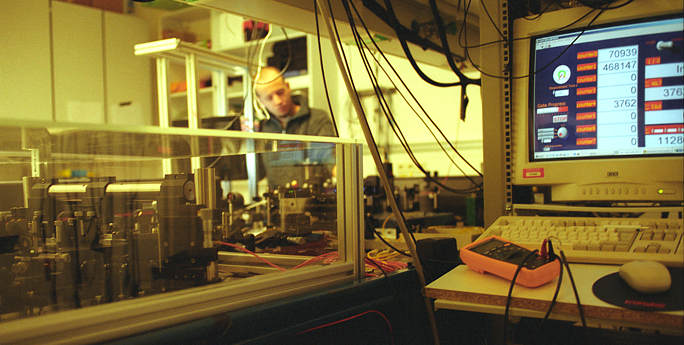
A peek into the quantum optics teleportation labs of Anton Zeilinger's group in Vienna, Austria and that of Paul Kwiat's group in Urbana-Champaign, Illinois.In the top photo to the left, the display shows the number of entangled photons being generated. In a few seconds, the count would be in the tens of thousands. The photo above and the next four below were taken by Scott Ready at Zeilinger's lab in December of 2004.
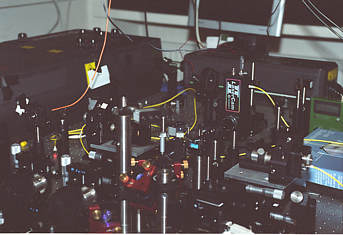
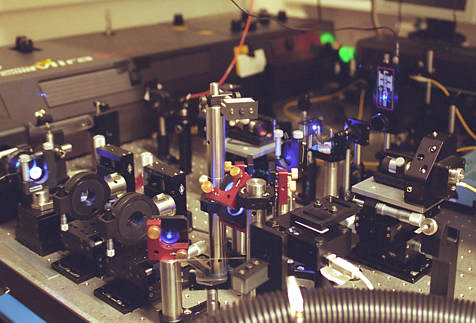
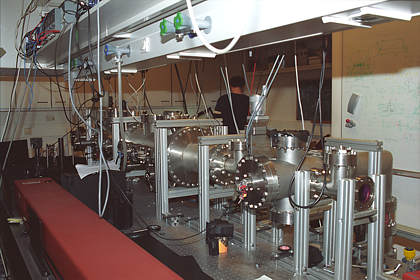
The machine shown directly above and below tests for whether there is a border where the strange behavior of atomic and subatomic particles fades away and the size of objects is closer to what one might see in a microscope.
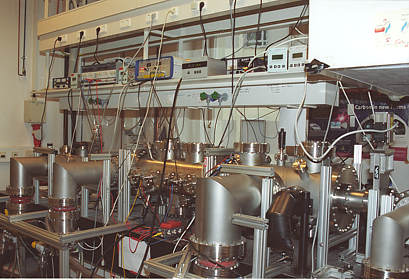
Shown below: three glimpses into Paul Kwiat's lab in February of 2010.
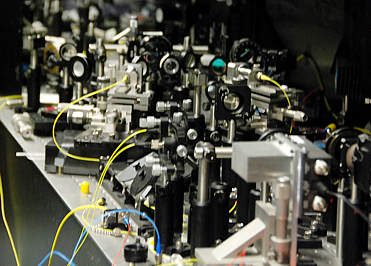
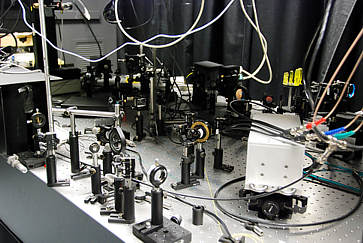
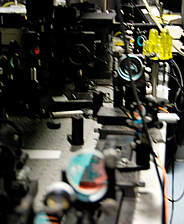
..to Supporting Site